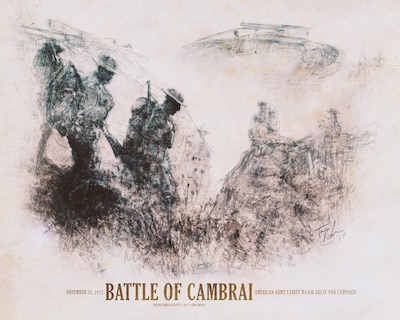By David Vergun Army News Service
WASHINGTON, Nov. 22, 2017 — The first American units saw
action in World War I during the battle of Cambrai, France, Nov. 20-Dec. 7,
1917. The same battle also showcased the first large-scale effective use of
combined arms, marking an evolution in warfare, said Brian F. Neumann, a
historian and World War I subject matter expert with the U.S. Army Center of
Military History.
The battle began with a successful British offensive against
the Germans, Neumann said.
Success of the offensive, he said, was due to the effective
coordination of combined arms, which included infantry, artillery, tanks and
combat air support. All were used to overrun the German trench lines in the
vicinity of the northern French town of Cambrai.
The use of combined arms gave the battlefield more of a
three-dimensional look, with air, tanks and artillery all supporting infantry,
along with some cavalry support, he said.
The British employed several hundred tanks, which were used
to overrun the German trenches and tear holes through their lines, he said. It
was the most significant utilization of tanks to date.
The Americans
The Army's role in the fighting was fairly limited, he said,
noting that it consisted of soldiers from the 11th, 12th and 14th Engineer
Regiments, who were engaged in railway construction work behind the trench
lines in support of the British.
Although America's role in the battle was limited, the news
that soldiers were finally engaged in a major battle for the first time since
war was declared in April made headlines and boosted morale on the home front,
he said.
By Nov. 30, the British had essentially outrun their supply
lines and artillery support, and that's when the Germans mounted a successful
counterattack, Neumann said.
Luck for the Army engineers ran out on that day as well,
when the Germans overran their area, resulting in 28 U.S. casualties.
The survivors regrouped and were reorganized into reserve
infantry with their main effort being to build trenches and help the British to
stabilize their lines, he said.
The Battle of Cambrai, though heralded for successful use of
combined arms, was actually a fairly typical World War I battle in that a
successful offensive was then met by a successful counteroffensive, with the
lines between friend and foe not shifting that much and a lot of casualties
taken on both sides: around 45,000 on each side, he said.
Although America had declared war against Germany seven
months earlier, the American Army wasn't yet ready for large-scale combat
operations, Neumann said.
While the roughly four U.S. combat divisions in France were
still in training in late 1917, he said, they would see plenty of action in
1918.







No comments:
Post a Comment